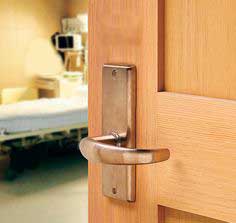In earlier days of construction, it was not unusual to see door hardware made of brass.  But nowadays, much of our hardware, including railings, has been replaced by aluminum and stainless steel. But did you know that there are proven antibacterial properties of copper and copper alloys like brass and bronze?
But nowadays, much of our hardware, including railings, has been replaced by aluminum and stainless steel. But did you know that there are proven antibacterial properties of copper and copper alloys like brass and bronze?
The COVID-19 virus is able to survive for up to three days on stainless steel, which turns doorknobs and handles into harbors for infection. This is one way the virus can spread quickly through a population. Copper and copper alloys are naturally antimicrobial. Some research even shows that copper can kill certain viruses on contact.
The Environmental Protection Agency (EPA) has registered as antimicrobial nearly 300 different copper surfaces, with copper registered as the first solid antimicrobial material. Its use has been evaluated for use on high-touch surfaces including door handles, bathroom fixtures and bed rails. And research done by the American Society of Microbiology (ASM) has firmly established the antimicrobial properties of copper surfaces. “Bacteria, yeasts and viruses are rapidly killed on metallic copper surfaces, and the term ‘contact killing’ has been coined for this process,” it reports.
History of the Antibacterial Properties of Copper & Copper Alloys
The ASM includes in its report the history of medical uses of copper dating back to Egyptian times. “The oldest recorded medical use of copper is mentioned in the Smith Papyrus, one of the oldest books know. This Egyptian medical text, written between 2600 and 2200 B.C., describes the application of copper to sterilize chest wounds and drinking water. Greeks, Romans, Aztecs, and others also used copper or copper compounds for the treatment of such ailments are headaches, burns, intestinal worms, and ear infections, and for hygiene in general.” Copper workers in 19th-century France appeared to be immune to cholera, and copper was used as an antimicrobial agent until antibiotics became readily available in 1932.
Copper Kills Viruses
When microbes that are transferred to surfaces by sneezing, coughing or vomiting land on copper surfaces, the copper releases ions that literally punch holes in the bacteria’s cell membranes, destroying the RNA and DNA held inside. This means the microbe cannot multiply, and dies off.
Some of the viruses that experience contact killing on copper and copper alloys include Staph, Influenza A, MRSA, and E-Coli, with varying lengths of time to become effective ranging from between 30 seconds to several hours. Even the superbugs are killed, including those that cause hospital-acquired infections. Worldwide studies show a 90% reduction in the number of live bacteria on surfaces when copper alloy is used on often-touched hospital surfaces.
The use of steel is popular in hospitals and medical facilities because it looks clean and shiny, while copper and brass can gain a tarnished patina and look dirty. Yet even when tarnished, it is bactericidal.
Composed of about 88% iron and 12% chromium, stainless steel does not impede the growth of bacteria. Stainless steel can also develop microscopic scratches and indentations from regular wear and tear. This leaves areas where viruses and superbugs can escape cleaning materials. In addition, stainless steel is cleaned likely only once a day. Copper works around the clock.
Related: Copper’s Known to Combat Viruses—Can it Help with Public Health?
Why Aren’t We Using More Copper as Antibacterial?
There are several reasons why healthcare isn’t using more copper. For one, they may not know about the antibacterial properties of copper and copper alloys. They may know that silver also has similar properties. However, silver requires moisture to become antimicrobial. It does not have the same reaction when dry.
Another reason may be cost. Antibacterial hand gels are commonly used, and are much less expensive, but they do not kill all microbes—like the norovirus, for example. In reality, making fittings from copper is no more expensive than stainless steel.
Contact Först Consulting Group
If you’d like to know more about copper and its antibacterial properties, or how and where to include copper in your home or building design, contact Först Consulting Group.




